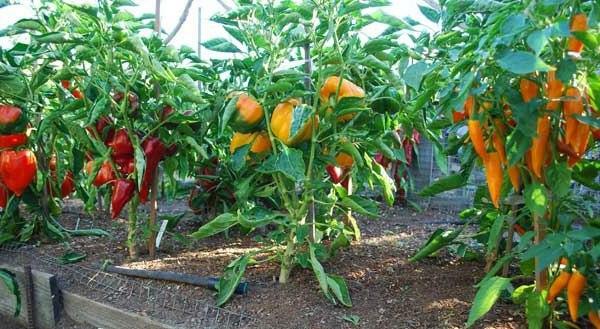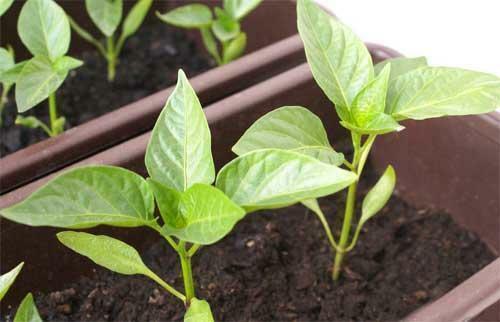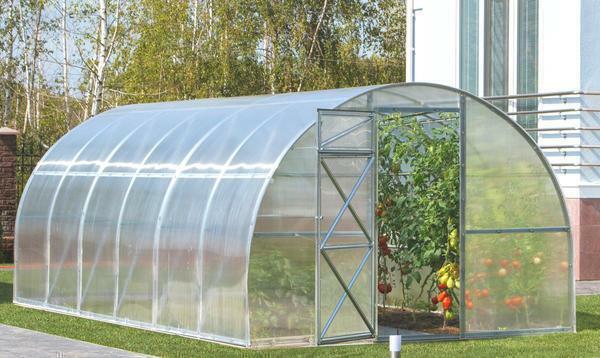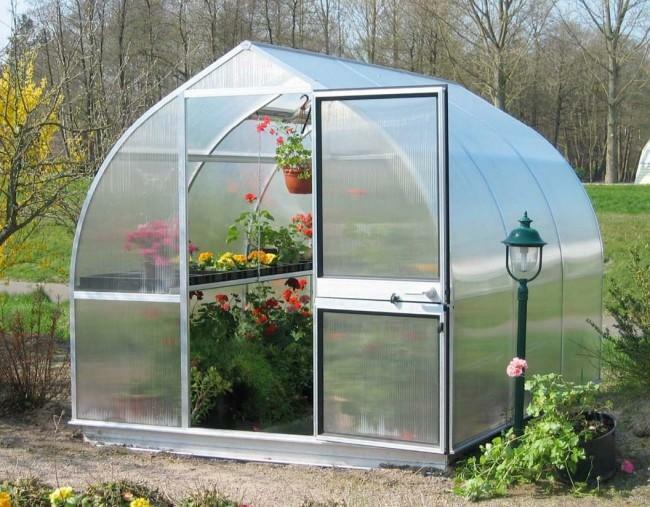 In order to get a decent result in the form of a good harvest, you need to adhere to a certain technology of growing Bulgarian pepper In winter, in vegetable shops you can see colorful sweet peppers at a sky-high price. Greenhouse fruits are beautiful, quite large, juicy and fragrant - few can resist them. Growing peppers in a greenhouse is easy, if you understand gardening and love this activity.
In order to get a decent result in the form of a good harvest, you need to adhere to a certain technology of growing Bulgarian pepper In winter, in vegetable shops you can see colorful sweet peppers at a sky-high price. Greenhouse fruits are beautiful, quite large, juicy and fragrant - few can resist them. Growing peppers in a greenhouse is easy, if you understand gardening and love this activity.
-
- Growing up Bulgarian pepper in a greenhouse: preparing seeds
- Pepper sweet growing in a greenhouse: planting seedlings
- Proper care for Bulgarian peppers in a greenhouse
- Pepper bulgarian growing and greenhouse care: plant disease
- Planting sweet pepper in the greenhouse( video)
Growing Bulgarian pepper in the greenhouse: preparing seeds
Our climate allows us to grow vegetables mainly in the warm season, whenplants get enough light and sun to ripen. The problem of growing plants in colder conditions has long been solved with the help of polycarbonate greenhouses or greenhouses. Cultivation of this pepper variety is a long process, therefore planting seeds for seedlings begins long before the planting of Bulgarian pepper
Pepper vegetation period from 80 to 180 days: the ultra-early varieties ripen in 80-90 days after pecking first shoots, The latest varieties require more than 150 days for full maturation.
Pepper is a plant that loves warmth. The optimum temperature for growth is 20-27 degrees, depending on the growing season. At 18 degrees, the plant feels uncomfortable, and if the temperature does not rise, it can disappear.
The choice of varieties of peppers is very large, each farmer decides which pepper to grow under cover. You can choose several varieties of different color and shape, the degree of maturation and the height of the plant.
Stages of growing Bulgarian pepper in a greenhouse or a greenhouse:
- Plant sprouts in small jars. You can buy peat tanks, and you can use plastic jars from yogurt.
- Duplicate and transplant sprouted seedlings into the garden. Soil for seedlings should be mixed with humus and peat and must be disinfected with a solution of potassium permanganate.
- Provide plants with comfortable conditions - optimum temperature, humidity and light. The yield of pepper depends on quality care.
First of all, you need to select weak or stale seeds. To do this, in a liter of water, dissolve 40 grams of table salt and pour out all the seeds. After 10 minutes, look at the result. Seeds come up - they can be thrown away. Set out the sown seeds, rinse and dry. Now they are ready to land. Before planting seeds in the ground, it is recommended that they "get pasted".To do this, put the seeds of peppers in a moistened gauze pouch for several days. After that, you can plant them in moistened soil.
Peppers sweet growing in the greenhouse: transplantation of seedlings
Seeds are planted in pots or plastic containers at a distance of 5 cm from each other. For 7 days, the seedlings are located in a room on the south side at a temperature of + 14 + 16 ° C.After that, the temperature should be raised to +24 oС in the daytime, dropping to +18оС at night. Seedlings should be watered once a week, do not allow excessive moisturizing.
 It is better to plant the sprouts of Bulgarian pepper in the ground on a cloudy June day or closer to the evening on a normal day.
It is better to plant the sprouts of Bulgarian pepper in the ground on a cloudy June day or closer to the evening on a normal day.
A month later, when the seedlings grow a little, you can dive it - sit in more spacious pots. In pots with a diameter of 10-12 cm, seedlings will grow until they land in the greenhouse. It is necessary to temper the pepper seedlings with sun rays, put the pots on the south side, and at the same time do not allow the drying of the land.
About 60 days have passed since the seed was planted - it is possible to plant sprouts directly in the soil of a greenhouse or a greenhouse. Seedlings of Bulgarian pepper are planted with an interval of 40 cm between plants.
It is not recommended to grow a number of bitter and sweet varieties, the pepper is easily perepylyaetsya, so all the fruits can turn out to be bitter.
The first 10-14 days of sweet peppers will adapt to new conditions, may look painful and drooping. It requires infrequent copious irrigation and loosening of the ground at the base to provide the root system with air.
Proper care for the Bulgarian peppers in the greenhouse
Bulgarian pepper does not like dry soil, so it is very important to arrange the correct watering of the seedlings in the greenhouse. To save time( after all, the greenhouse can be quite large), you can install auto-irrigation - sprinkling, intrasoil or drip. The choice of this or that method of irrigation depends on the cultivar of the Bulgarian pepper.
 The care for Bulgarian pepper takes place during the hottest period, at this time the seedlings are planted, requiring constant care for it.
The care for Bulgarian pepper takes place during the hottest period, at this time the seedlings are planted, requiring constant care for it.
It is important for the polycarbonate greenhouse to install a heating system, since at low temperatures the pepper simply will not survive. In the design it is possible to install electric radiators, gas boilers with heating pipes, water heating.
It is important to install a temperature sensor that will regulate the temperature throughout the day.
For normal development of seedlings of Bulgarian pepper, good lighting is necessary. This can be achieved thanks to LED-daylight lamps. Day of sunlight should be enough, but after sunset you need to refresh.
When growing Bulgarian peppers it is important to monitor the appearance of aphids or mites that can damage the plant. He is afraid of pepper and Colorado beetle and whitefly. From such misfortunes will save the biological drug Fitoverm. Its use does not harm the plant and is harmless to humans. To prevent the appearance of rot, wilt or bacteriosis, you need to sprinkle pepper with Phytosporin or Trichodermine at the slightest sign.
Tall pepper varieties need a garter, otherwise brittle stems under the weight of the fruit can break off and disappear. For better pollination, some farmers came up with a way to spray the flowering seedlings with a solution of honey. Sweet water should attract bees for further pollination.
Proper agricultural technology when preparing soil and greenhouses for the season will prevent the appearance of diseases and pests.
Bulgarian pepper cultivation and care in the greenhouse: disease of plants
Bulgarian pepper, like many plants, is exposed to diseases and insect damage. Do not rule out such misfortunes in the greenhouse.
 Pepper care in a greenhouse or greenhouse assumes strict implementation of all agrotechnical techniques
Pepper care in a greenhouse or greenhouse assumes strict implementation of all agrotechnical techniques
It is important to identify the threat in the first stage and eliminate it as quickly as possible using non-hazardous means.
Very often the harvest of Bulgarian pepper can be threatened due to diseases. It is not excluded, and damage to aphids, Colorado beetle, mites.
Diseases of Bulgarian pepper:
- Black leg. The frequent reason is excessive watering, thick planting of seedlings, frost.
- Stool. Distributed by insects. The main signs are the yellowing leaves and the irregular shape of the fetus.
- Fusarium. Blackening of the stem and roots of the plant, as well as damage to the fruit.
- Gray rot. Appears on peppers due to excessive watering.
- The vertebral disease. Fungus affects fruit, the reason is the lack of water in the soil.
When slugs appear, sprinkle the dry soil with ground black or red pepper. The control of aphids is the treatment of plants with tincture of the usual nettle, which must be added to water for irrigation.
It should be remembered that the best methods of preventing diseases are prevention and proper care of the plant.
Planting sweet peppers in the greenhouse( video)
Cultivation of Bulgarian pepper in a greenhouse is a troublesome business. Small difficulties can arise when planting seeds and caring for sprouts at home. After planting the plants in the greenhouse, it is important only to maintain their livelihoods and monitor the appearance of pests.


